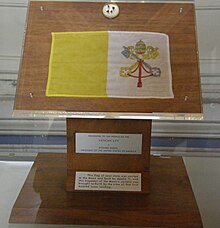Flag of Vatican City

 National flag. Flag ratio: 1:1
National flag. Flag ratio: 1:1

The flag of Vatican City was adopted on June 7, 1929, the year Pope Pius XI signed the Lateran Treaty with Italy, creating a new independent state governed by the Holy See. The Vatican flag is modeled on the flag of the earlier Papal States.
The flag
The flag consists of two vertical bands, one of gold (hoist side) and one of white with the crossed keys of Saint Peter and the Papal Tiara centered in the white band. The crossed keys consist of a golden and a silver key, in which the silver key is placed in the dexter position. The flag is one of only two square country flags in the world, the other being the flag of Switzerland. The yellow and white stripes break the heraldic rule of tincture.
The Vatican City coat of arms can be found in the white half. The coat of arms consists of:
- the papal tiara (as used under the pontificate of Pius XI);
- the two keys which represent the keys to Heaven (according to the Gospel of Matthew 16:19) given by Jesus Christ to St. Peter. The popes are regarded as the successor of Peter, and the gold and silver keys have been significant elements in the symbolism of the Papal State since the 13th century. The gold represents spiritual power, while the silver key represents worldly power.
- a red cord connecting the keys.
The yellow and white of the flag also refer to the keys – in heraldic terminology, there is no distinction between yellow and gold (the metallic color or), nor between white and silver (argent).
The flag is flown or displayed worldwide in Roman Catholic churches and institutions, usually alongside the national flag of where the church or institution is located.
The crossed keys was the Papal States coat of arms showing how important the Papal States were to Vatican City.
The flags of the Papal States
See also
References
- ^ a b "Bandiera pontificia". Stato della cità del Vaticano. Retrieved 2008-07-09.
Anticamente la bandiera dello Stato pontificio era giallorossa (o per meglio dire amaranto e rossa, colori derivati dai colori dello stemma della Santa Sede), i due colori tradizionali del Senato e del Popolo romano, che vennero tuttavia sostituiti con il bianco e il giallo nel 1808, allorché Pio VII
Template:It icon
External links
- Vatican City at Flags of the World
- Flag of Vatican City by Rev. William M. Becker

![Flag of the Papal States prior to 1808.[1]](http://upload.wikimedia.org/wikipedia/commons/thumb/2/29/Flag_of_the_Papal_States_%28pre_1808%29.svg/120px-Flag_of_the_Papal_States_%28pre_1808%29.svg.png)
![Flag of the Papal States between 1808 and 1870.[1]](http://upload.wikimedia.org/wikipedia/commons/thumb/2/20/Flag_of_the_Papal_States_%281808-1870%29.svg/120px-Flag_of_the_Papal_States_%281808-1870%29.svg.png)
